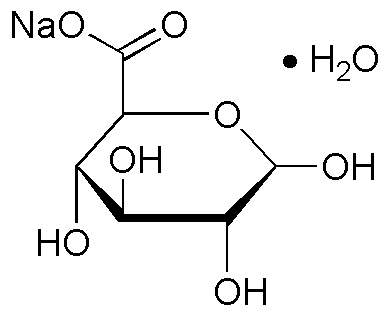D-Glucuronic acid sodium salt monohydrate is widely utilized in research focused on:
- Pharmaceutical Development: It serves as a key ingredient in drug formulations, enhancing solubility and bioavailability of active compounds, which is crucial for effective medication delivery.
- Detoxification Processes: This compound plays a significant role in the detoxification of drugs and toxins in the liver, making it valuable in studies related to liver function and metabolic pathways.
- Cosmetic Applications: It is used in skincare products for its moisturizing properties and ability to improve skin texture, appealing to the beauty and personal care industry.
- Food Industry: As a food additive, it can be utilized to enhance the nutritional profile of products, providing health benefits that attract health-conscious consumers.
- Research in Glycobiology: This compound is essential for studying glycosaminoglycans and their biological roles, offering insights into cell signaling and disease mechanisms.
General Information
Properties
Safety and Regulations
Applications
D-Glucuronic acid sodium salt monohydrate is widely utilized in research focused on:
- Pharmaceutical Development: It serves as a key ingredient in drug formulations, enhancing solubility and bioavailability of active compounds, which is crucial for effective medication delivery.
- Detoxification Processes: This compound plays a significant role in the detoxification of drugs and toxins in the liver, making it valuable in studies related to liver function and metabolic pathways.
- Cosmetic Applications: It is used in skincare products for its moisturizing properties and ability to improve skin texture, appealing to the beauty and personal care industry.
- Food Industry: As a food additive, it can be utilized to enhance the nutritional profile of products, providing health benefits that attract health-conscious consumers.
- Research in Glycobiology: This compound is essential for studying glycosaminoglycans and their biological roles, offering insights into cell signaling and disease mechanisms.
Documents
Safety Data Sheets (SDS)
The SDS provides comprehensive safety information on handling, storage, and disposal of the product.
Product Specification (PS)
The PS provides a comprehensive breakdown of the product’s properties, including chemical composition, physical state, purity, and storage requirements. It also details acceptable quality ranges and the product's intended applications.
Certificates of Analysis (COA)
Search for Certificates of Analysis (COA) by entering the products Lot Number. Lot and Batch Numbers can be found on a product’s label following the words ‘Lot’ or ‘Batch’.
*Catalog Number
*Lot Number
Certificates Of Origin (COO)
This COO confirms the country where the product was manufactured, and also details the materials and components used in it and whether it is derived from natural, synthetic, or other specific sources. This certificate may be required for customs, trade, and regulatory compliance.
*Catalog Number
*Lot Number
Safety Data Sheets (SDS)
The SDS provides comprehensive safety information on handling, storage, and disposal of the product.
DownloadProduct Specification (PS)
The PS provides a comprehensive breakdown of the product’s properties, including chemical composition, physical state, purity, and storage requirements. It also details acceptable quality ranges and the product's intended applications.
DownloadCertificates of Analysis (COA)
Search for Certificates of Analysis (COA) by entering the products Lot Number. Lot and Batch Numbers can be found on a product’s label following the words ‘Lot’ or ‘Batch’.
*Catalog Number
*Lot Number
Certificates Of Origin (COO)
This COO confirms the country where the product was manufactured, and also details the materials and components used in it and whether it is derived from natural, synthetic, or other specific sources. This certificate may be required for customs, trade, and regulatory compliance.


